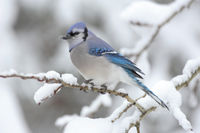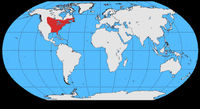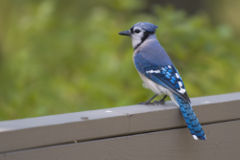Blue Jay
Conservation status Least concern |

|
|
Scientific classification |
| Kingdom: |
Animalia
|
| Phylum: |
Chordata
|
| Class: |
Aves
|
| Order: |
Passeriformes
|
| Family: |
Corvidae
|
| Genus: |
Cyanocitta
|
| Species: |
C. cristata
|
|
|
Binomial name |
Cyanocitta cristata
Linnaeus,
1758 |

Blue Jay range
|
The Blue Jay (Cyanocitta cristata) is a
North American
jay,
a handsome bird with predominantly lavender-blue to mid-blue
feathering from the top of the head to midway down the back.
There is a pronounced crest on the head. The colour changes
to black, sky-blue and white barring on the wing primaries
and the tail. The bird has an off-white underside, with a
black collar around the neck and sides of the head and a
white face.
Blue Jays reside over a very large area of the eastern
side of
North America from Newfoundland in the northeast to Florida
in the southeast and westward to Texas and the mid-west and
eastern Colorado in the north. It is mainly a bird of mixed
woodland, including American beech and various oak species,
but also of parks and gardens in some towns and cities. West
of the Rockies, it is replaced by the closely related
Steller's Jay.
Its food is sought both on the ground and in trees and
includes virtually all known types of plant and animal
sources, such as acorns and beech mast, weed seeds, grain,
fruits and other berries,
peanuts, bread, meat, eggs and nestlings, small
invertebrates of many types, scraps in town parks and
bird-table food.
Its occasionally aggressive behavior at feeding stations,
plus a reputation for occasionally destroying the nests and
eggs of other birds, has made the Blue Jay unwelcome at some
bird feeders. However, these are clever and adaptable birds
who are good survivors and have adapted well to human
presence. They are particularly fond of peanuts and
sunflower seeds.
Any suitable tree or large bush may be used for nesting
and both sexes build the nest and rear the young, though
only the female broods them. There are usually 4–5 eggs laid
and incubated over 16–18 days. The young are fledged usually
between 17–21 days. Blue Jays typically form
monogamous pair bonds for life.
Although this bird is generally found year round through
most of its range, some northern birds do move into the
southern parts of the range. These birds
migrate during the day.
The voice is typical of most jays in being varied, but
the most commonly recognized sound is the alarm call, which
is a loud, almost
gull-like scream. There is also a high-pitched
jayer-jayer call that increases in speed as the bird
becomes more agitated. Blue Jays will use these calls to
band together to drive a predator such as a
hawk away from their nest.
Blue Jays also have a quiet, almost subliminal call which
they use among themselves in close proximity. In fact, they
can make a large variety of sounds, and individuals may vary
perceptibly in their calling style.
As with other blue-hued birds, the Blue Jay's coloration
is not derived by
pigments, but is the result of light refraction due to the internal structure of the
feathers; if a Blue Jay feather is crushed, the blue
disappears as the structure is destroyed. This is referred
to as
structural coloration.
The Blue Jay is the provincial bird of Prince Edward
Island and gave its name to the Toronto Blue Jays baseball team.
Blue Jays in captivity are generally aggressive toward
other birds. They tend to bond to one or two people and
attack all others.
References
- BirdLife International (2004).
Cyanocitta cristata. 2006
IUCN Red List of Threatened Species.
IUCN 2006. Retrieved on 09 May 2006. Database entry
includes justification for why this species is of least
concern
- Goodwin, D. 1976. Crows of the World.
Seattle, University of Washington Press.
- Madge, S. and H. Burn. 1994. Crows and Jays: A
Guide to the Crows, Jays and Magpies of the World.
Boston, Houghton Mifflin.
- Tarvin, K. A., and G. E. Woolfenden. 1999. Blue
Jay (Cyanocitta cristata). In The Birds of North
America. No. 469.
External links

Blue Jay surveys its surroundings




